St. Roch Redesign
St.Roch | Section #8
This video showcases some struggles a kid can face as a resident of the community of St. Roch, especially if they mean to cross the train tracks. The community of St. Roch has a lot of character of its own, but like everything, there is always room for improvement, which is what many of these suggestions look to accomplish.
The first possible improvement showed in the video is a pedestrian bridge. This suggestion was made based on the idea that kids have very little options for transportation, therefore it would be extremely beneficial to provide them with a comfortable area for them to walk freely between communities. Not only this but adding a pedestrian bridge for this site also makes for the possibility of adding a rain garden in the area as well as a clear pathway lighter with pedestrian-scale lights.
Another option that has been proven to make pedestrians feel comfortable while walking to their destinations is properly lighter pathways. Therefore, this has been another proposal for the video addresses. Much like the pedestrian bridge, improving pathways with light also opens the possibility of improving plantings along with areas with the goal of managing stormwater on-site, being the third possible proposed improvement in this video.
While these are all solutions that have been proven effective in other cities, this does not mean that they are the only possible options for the city of New Orleans. The goal of this video is to show the room for improvement as well as the do-ability of the different projects. Enjoy
Rotterdam, The Netherlands
 Most of the Netherlands lies below sea level, this puts The Netherlands at greater risk and exposure to climate change than many other countries. People call the dutch are the worlds go tos water management experts, but why is that? This may have to do with the fact that the Dutch see water as part of their land, they appreciate it and enjoy its benefits. Therefore, they see rising sea levels, as well as climate change as an opportunity to innovate and grow as a country.
Most of the Netherlands lies below sea level, this puts The Netherlands at greater risk and exposure to climate change than many other countries. People call the dutch are the worlds go tos water management experts, but why is that? This may have to do with the fact that the Dutch see water as part of their land, they appreciate it and enjoy its benefits. Therefore, they see rising sea levels, as well as climate change as an opportunity to innovate and grow as a country.
Clearly, The Netherlands will get affected by rising sea levels, therefore they figured out a way to live with them and not try to prevent them. By simply opening a dam they are far safer than they would have been if it would be full all the time thanks to the relief in pressure. They also created a special dam, the size of the Eiffel Tower, that opens and closes as needed, making the ocean water come into the city at a slower rate, preventing floods and devastation. This shows how the Dutch understand climate change and are determined to adapting their lives to it instead of stopping it.
a way to live with them and not try to prevent them. By simply opening a dam they are far safer than they would have been if it would be full all the time thanks to the relief in pressure. They also created a special dam, the size of the Eiffel Tower, that opens and closes as needed, making the ocean water come into the city at a slower rate, preventing floods and devastation. This shows how the Dutch understand climate change and are determined to adapting their lives to it instead of stopping it.
Additionally, one of the most exemplary examples of making a city resilient to climate change is their floating initiative. Rotterdam currently is the host for the first floating pavilion as well as floating trees! and no, they are not mangroves!

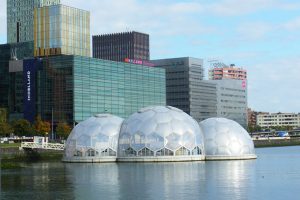
This initiative is not only being implemented in Rotterdam but in Amsterdam as well. the city of Amsterdam is the host for the first community of floating houses, with the count being around 90 houses. These structures are designed to rise according to sea level, making it more resilient to this and other effects of climate change. You can see more in detail this concept on the video below.
 Now, this does not mean that the only thing we, in America and the rest of the world, have to do is to learn to live with rising sea levels, on the contrary. Drastic changes need to be made in order for climate change to subside and to give the earth the time to recuperate. We need to change our lifestyle, and this is something that the Dutch have already made peace with and have been implementing for years.
Now, this does not mean that the only thing we, in America and the rest of the world, have to do is to learn to live with rising sea levels, on the contrary. Drastic changes need to be made in order for climate change to subside and to give the earth the time to recuperate. We need to change our lifestyle, and this is something that the Dutch have already made peace with and have been implementing for years.
Like mentioned in the Child-Friendly City post for The Netherlands, this country is mostly designed with pedestrians in mind, where the main way of transportation is via public transport or bicycles! The Netherlands is home of approximately 800,000 bikes, subsequently, lowering the amount of pollution going into the atmosphere, and contributing to a society where communities feel safe and included. This means that as humans, we should design places that are friendly to both the environment and the people in order to be able to live a truly peaceful and high-quality life.

Adapting to Climate Change
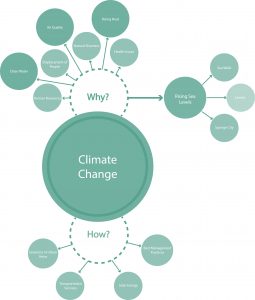
In recent years, there has been a change in climate patterns. The average global temperature has increased at fast rates due to the high levels of carbon dioxide produced by the constant use of fossil fuels. Today, we are continuing to see the drastic effects this has on our planet and actions are needed to be taken immediately. Some big challenges that cities are facing include traffic pollution, high-rise living and urban sprawl, and inadequate and unequal access to the city. Cities are in need of less cars and traffic, more public spaces, and better air quality from cleaner energy sources.
Adapting coastal cities to respond to climate change not only includes adaptation strategies, but also resilience-based approaches. Popular methods against rising sea levels include sea walls and dam barriers, levees, and the “Sponge City” method. The “Sponge City” method is the concept of creating a city that can take in all the stormwater that comes its way. It is an efficient way of making use of stormwater and controlling where it goes. This method includes replacing concrete pavements with wetlands as well as implementing more green rooftops and rain gardens. In the end, it is all about using a combination of approaches with environmental-based solutions at a lower cost to avoid relocation.
Some other ways to work towards this and against climate change involve implementing more plants and trees, incorporating passive solar design, making more use of natural ventilation, and implementing more stormwater management practices. The advantage of using greenery in a design is not only good for the environment, but also for the mind. The more greenery an urban setting has, the higher effects of a positive health and well-being of the people within the place. Another simple, but big way communities can get involved to help fight against climate change are community gardens. Not only do they reduce the number of errands, but they also increase health and fitness as well as bring together an even stronger community.
The Netherlands
![]() Why the Netherlands?
Why the Netherlands?
In 2013, UNICEF rated Dutch children to be happiest in the world, while children in the US were ranked 26, why is that? One might think that this is because they might have expensive objects to play with, or they come from a higher class, but in actuality its the complete opposite. The Netherlands has one of the best education systems in the world, as well as one of the healthiest environment to grow up in. Kids are being raised like equals to their peers, making the community almost free of discrimination or bullying, kids play outside most of the time while feeling safe, are used to receiving second creating a sense of gratitude as a community, there is a strong family bond within the whole country where parents trust their children and vice-versa, hence giving them the freedom to explore their likes and dislikes, and much more. Now, what can we implement in a North American community that might give us similar effects

City Planning![]()
I believe that one big part of the success of the Netherlands is its design. Many Dutch cities are designed to be pedestrian-friendly, inclusive and green. In fact, The Netherlands has a bike “population”of about 880,000 bikes! Believe it or not all these aspects play a role in people’s behavior. People feel safer while being outside and are more aware of their environment due to the government’s implementation of green infrastructures around cities. Because of this children are able to spend quality time outside and bring positivity to the classroom and their homes. Pair these aspects with families acceptance of their kid’s individuality and allowing them the freedom to express it, as well as teaching gratefulness for the simple things and that is a formula for success! Watch the video below for a closer insight on the life of a dutch family.
 CHANGE YOUR MINDSET!
CHANGE YOUR MINDSET!
Now that we have a happy community, the next challenge is to preserve their homes. We all know that climate change is unpredictable and an issue that needs addressing immediately. Something we can learn from the Netherlands is their attitude towards it. They see climate change as an opportunity for improvement and embrace it. A major way they have already started doing so is building with the sea level in mind, and building houses in the water, on platforms that have the ability to change levels along with the sea. If we were to start by adapting the Dutch attitude about climate change into the way we design, there are no questions communities would experience exponential benefits. To know more in detail about how The Netherlands manages climate change issues click here!
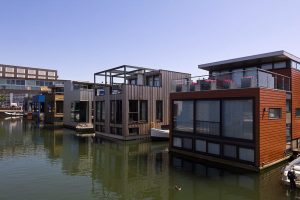
Floating houses of the Netherlands
References:
Hutchison, Rina Mae Acosta; Michele. “They Raise the World’s Happiest Children – so Is It Time You Went Dutch?” The Telegraph, Telegraph Media Group, 13 July 2018, https://www.telegraph.co.uk/family/parenting/raise-worlds-happiest-children-time-went-dutch/.
Mecking, Olga. “Are the Floating Houses of the Netherlands a Solution Against the Rising Seas?” Pacific Standard, 21 Aug. 2017, https://psmag.com/environment/are-the-floating-houses-of-the-netherlands-a-solution-against-the-rising-seas.
Making a City Resilient
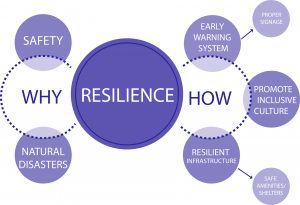
A big concern is how coastal cities will be adapting infrastructures to respond to climate change. The answer is sustainable behavior and green infrastructure. It is about using strong building materials while also bringing bits of nature into neighborhoods. The implementation of greenery within a space brings many advantages to a design and there are many reasons why it is so important.
To build a resilient city means to build a place that has the ability to withstand or recover from any difficulties. This happens by designing and prioritizing spaces that encourage safe movements and social interaction. It is crucial that a place is provided that is safe and can prevent or hold through major losses from natural disasters.
But how do you make a city resilient? Strong infrastructure materials can withstand during extreme weather conditions and natural disasters. This will prevent any major damages or loss as well as save communities from having the rebuild. It is important to save buildings and avoid new unnecessary construction that will generate more heat and disrupt existing vegetation. Early warning systems for people are also crucial. Many places lack proper mapped signages. Taking these subjects more seriously will create an efficient and educated community. And lastly, with resilient infrastructures comes safe amenities and shelters. With more amenities that prioritize the safety and well-being of the people within the community, the city is just getting closer to a more inclusive culture and a successful city.
Making a City Inclusive
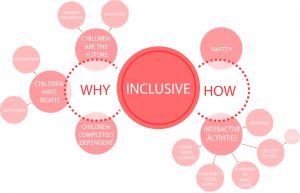
Starting a Child-Friendly initiative does not mean making a city more comfortable for families with kids, it means including kids on the design process of the city they are going to live in. There are many reasons why it is extremely important to involve children if we wish to have a successful Children Friendly City. As we can see in the diagram above, children, most importantly, have rights, just as adults do, although it’s easy to forget given the fact that children are simultaneously extremely dependent on adults, therefore constantly outspeaking and even discriminating them. For this reason, we need to keep in mind that children are in fact the future of society, which is why, if they don’t have a voice regarding decisions that involve the places where they are growing up, they are less likely to have an enjoyable childhood.
Now, how do we do that? How can adults implement the crazy ideas that kids come up with? Many might think that children’s ideas are extremely far fetched, after all, children don’t understand concepts like liability, budget, time, etc, right? Well even though children might be oblivious to these concepts that adults consider all the time before making a decision, they do understand what they need! There are precedents that prove that when we let children have an opinion on the design and planning process, what they design makes it inclusive, not only for them but for other demographics such as the elderly, and disabled, which many adults tend to forget about. Since kids are completely dependent on adults, they can’t just go anywhere they want easily, which means that if we design a place that is easy for children to access, it means it’s easy for everybody else in the community to access! A kid has an infinite amount of possibilities that must be explored and taken into consideration, but how?
There are many ways we can make children share their ideas while at the same time making them easy to understand for our not as imaginative minds. As you can see in the diagram, we have mentioned some of the many possible ways kids can get involved in the design process, be it with a designer on the room or from far away, thanks to social media. Having kids draw their ideas or physically build them with materials such as legos is a great way to make a young child idea come to life. As kids get older, these approaches might not be as appealing, so what about they plan using video games like Minecraft, or share their own designs through contests on social media. In the end, there are an infinite amount of ways kids can tell us what they envision their childhood to be, it is up to us now to listen to their infinite ideas, and deliver.
References:
Talks, TEDx. “We Let Kids Design Our City — Here’s What Happened | Mara Mintzer | TEDxMileHigh.” YouTube, YouTube, 1 Feb. 2018, https://www.youtube.com/watch?v=9cudn_vSdCY.
“Why Build a Child-Friendly City?” Child Friendly Cities Initiative, https://childfriendlycities.org/why-build-a-child-friendly-city/.